Olive Culture as European Heritage
The cultivation of olive trees and products, a prominent agricultural sector in the Mediterranean Basin, is recognized as an icon of traditional Mediterranean culture. Notwithstanding declining economic prevalence in the previous centuries, it is strongly promoted today as a heritage object in most Mediterranean countries, regaining cultural and economic value. As such, its role in […]
The cultivation of olive trees and products, a prominent agricultural sector in the Mediterranean Basin, is recognized as an icon of traditional Mediterranean culture. Notwithstanding declining economic prevalence in the previous centuries, it is strongly promoted today as a heritage object in most Mediterranean countries, regaining cultural and economic value. As such, its role in maintaining European identity is both unifying and excluding:[1] it enhances distinction between Europe’s south and north, while connecting the classical Mediterranean cultures (Greece, Cyprus, Italy, South-France, Spain, Malta) with non-Mediterranean (Portugal, Slovenia, Croatia), as well as adjacent Mediterranean ones (Turkey, the Middle-East, North-Africa), albeit by way of competition. Promoting olive heritage serves as a lever for agriculture, gastronomy, tourism, environment and landscaping.
A historical perspective on olive cultivation and production
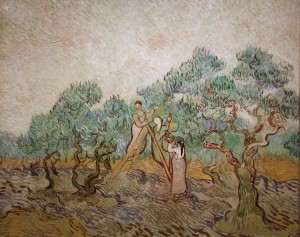
The Olive Orchard by Vincent van GoghA crop typical to the Mediterranean, thanks to heavy yields and adaptability to poor soils, olives have been cultivated in the Levant ever since 8000 – 5000 BCE and domesticated since 3700 – 3500 BCE,[2] and have gradually spread and acculturated in other parts of the Mediterranean. For ages, olive oil production has continuously consisted of the traditional stages of harvesting, cleaning, crushing, mixing, and separation.[3] Around 5000 BCE, olives were crushed using stone wheels in individual households, and separation was made by hot water (replaced with diaphragm presses in the Post-Hellenistic period). Since around 1300 BCE, olives were collected and compressed in woven mats, and around 50 BCE in wooden and iron screw presses. Expansion of olive oil production occurred after 1700, resulting from population growth. By then, horses were used for turning the crushing wheels. After 1950, hydraulic presses were introduced for separation.[4] In the late 19th century, the demand for olive oil dropped, due to widespread poverty and growing competition placed by cheaper seed oils, which triggered the decline of its quality. Despite risks and instability, today this sector prospers again, with 600 million productive olive trees on over 7 million hectares across the world.
Olive-based agriculture in Europe today: tradition and modernity
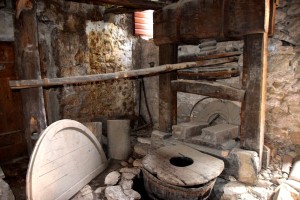
Ancient oil press in olive oil production workshop from the 17th century. The workshop is located in the summer house in Trsteno, national heritage site of Croatia, built in the 15th centuryOlive-based agriculture is prevalent in EU’s southern countries with about 5 million hectares of plantations and over €7,000 million production value annually, most of which consists of olive oil (only in Greece table olives constitute more than 10% of olive groves).[5] In certain areas, it amounts to 100% of the GDP. With about 1,509,000 farms of olive plantations (in 2013), EU is not only a major consumer market but also the world’s main exporter, providing 70 to 75% of world olive oil production and more than 30% of table olives. To sustain this leading role, EU legislation establishes regulations of development and assistance to producers, handling environmental issues and plant diseases, production quality and trade. EU and national level efforts, second only to these in the wine sector, are invested in controlling olive oil marketing standards, preventing food fraud (e.g., mixing oils, or false classifications as « organic », « regional », etc.), and securing the image of olive oil as a quality product, especially in the category of extra virgin oils.
99% of EU olive products come from Spain, Italy, Greece and Portugal, among which Spain leads as a grower (with more than half of the plantations in EU) and an exporter. Overall, the olive sector in EU is based on smaller farms than other agricultural sectors. In contrast to Spain and Portugal, where farms are usually medium-sized or large (reaching 5.8 hectares per farm in Spain and 2.8 in Portugal, in 2013), in Italy and Greece most of the olive groves are cultivated by small farms (with less than 2 hectares in average).[6] The structure of the labor force differs accordingly, with 17% paid non-family members working in farms in Spain, in contrast to 1% in the other countries, where smaller units based on family work are predominant. The total of about 1,300,000 regular farm laborers specializing in olives (in 2013) constituted 18% of the overall farm laborers in the nine producing countries (ranging from 35% in Spain to less than 1% in France, Malta and Slovenia).
While cohabitation between modernized and small traditional units remains typical, a modern industrial system is currently developed, maximizing efficiency and yields and reducing time and work-force. Led by Spain and Portugal, it consists of new, larger, high-density irrigated plantations (as opposed to the traditionally low-density, non-irrigated small groves, often in terraces), using artificial fertilizers and pesticides, and mechanization of harvesting and oil pressing. Nevertheless, production intensification has its hazards in terms of sustainability, due to climate change, fragile environments and topographies (e.g., slopes and old terraces), harmful production and waste disposal methods, or the limited adaptability of the trees themselves, as perennial crops. This, in turn, stimulates innovative techniques of cultivating and harvesting, pest and waste management, landscape preservation, etc., to allow sustainable groves, less exposed to market volatility, in smaller productive units.
Olive heritage industry: canonization and popularization
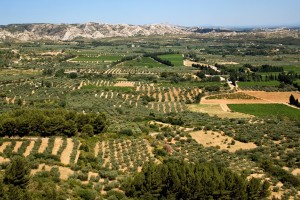
Les Baux-de-ProvenceThe reputation of olive production hinges massively on the propagation of olive culture by a thriving field of mediators, beyond growers and producers. This sector comprises suppliers and service givers, consultants and critics, as well as researchers, who establish a professional discourse, test laboratories and evaluation codes, creating distinction and hierarchy between expert and lay taste among growers, companies and consumers. Classifications of olive species, variants of Olea Europaea, are elaborated.[7] Olive fruits and oils (edible and medicinal), differing in shapes, colors, tastes and other qualities, are constantly cultivated, examined and put in competition through labeling (e.g., « extra virgin », « organic », or by brands), certifications, and other procedures, all of which guarantee attributing them authenticity and finesse. All this accelerates the formation of a connoisseur olive culture, on the one hand, and its wide popularization, on the other, endorsing the recognition of olive-related knowledge and consumption-practices as elements of a sophisticated lifestyle.
Heritage is an important agency in this dynamics. Rather than a finalized fixed product, scholars of heritage see it as an ongoing process, constantly reshaped by changing power relations and ideologies in search for legitimacy, moving between seduction (i.e., reification of practices and meanings) and disenchantment (i.e., inciting conflict, thereby reconfiguring cultural spaces).[8] In both cases, longevity serves as a major asset. With the presence of wild and ancient olive trees (some of which are estimated, depending on the measurement techniques, to be several hundred years old, and in some cases, mainly in the Levant regions, over 1000 years),[9] the myth of the ‘olive tree civilizations’ is perpetuated, crowning the olive a sacred tree of enduring Mediterranean customs and rituals. Evoking ancient sources (notably the Hebrew Bible, the Greek mythology, Roman poetry or ancient Christian art), olive trees, branches and wreaths, or oil, have become emblems of peace, wisdom and progress, ornamenting coins and seals, coats of arms and symbols of municipalities or states (e.g., Cyprus, Israel), and being awarded in ceremonies (e.g., to Olympic victors, or in weddings). Olive trees of Gathsemane in Jerusalem are revered by Christians as Christ’s last prayer place.[10] Similarly, the biblical myth of ‘the dove with the olive branch’ (Genesis 8:11), has become a universal popular expression.
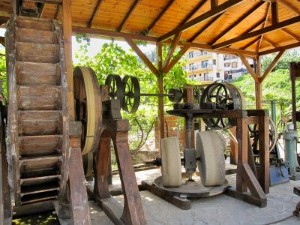
Old olive pressing machinery, Thassos, GreeceAt the same time, olive groves and olive products have become tourist attractions,[11] massively exploiting – and contributing to the sanctioning of – olive heritage. Another feature of olive heritage inculcated through tourism is rurality and locality. The status of olive groves as a perennial element shaping the landscape and life of EU rural southern regions is celebrated, together with that of olive oil as an icon of Mediterranean cuisine and of traditional healthy food. These qualities are disseminated by Romantic art as well as by local crafts (e.g., wood carving), cook books, magazines and travel guides. Similarly, they are propagated through intensive activities launched by EU and national agencies, NGOs and local municipalities. These activities include festivals and fairs during the harvesting period, exhibitions and local museums, European and international oil quality competitions,[12] and local or European olive trails. The prominent one among the latter is the ‘Routes of the Olive Tree’,[13] which runs through several Mediterranean countries (including non-European ones). Inaugurated in 1998, it is organized by the Euro Mediterranean Olive Tree Cultural Foundation based in Messenia (Greece), with the cooperation of other institutions, organizations, universities and Chambers of Commerce in Mediterranean and European countries.
The effectiveness of top-down olive heritage policies inevitably hinges on bottom-up local activities. Olive tourism also entails private initiatives, such as local Olive-Tree tours, family-based vacation facilities, restaurants and bars. Concentrating on rural tourism, it also markets trendy ‘experience visits’ in old olive orchards, traditional olive presses and seasonal harvesting sessions, as well as bourgeoning local olive-based crafts, cosmetics and health industry and gardening. Among the consequences of the thriving olive heritage industry are the increase in household consumption of olive oil – promoted as health and exquisite ingredient in recent decades,[14] as well as in the decorative use of olive trees for gardening, which is often criticized as a pretentious, anti-environmental, culturally offensive practice.
Social and political roles of olive heritage
Whereas from a global-European perspective olive heritage and economy are a shared element, distinguishing the southern countries from the rest of Europe, from the viewpoint of local settings it varies and stirs competition between nations and regions. The high symbolic value of olive heritage is sometimes revealed by the efforts invested in mobilizing it in disproportion to the actual impact of olive culture in a certain region. In such cases, it often echoes (and reflects aspirations to) the image of a nation or a region as viewed from the outside. In Malta, for instance, the sentiment for a Mediterranean culture (and particularly Mediterranean gastronomy), embedded in the promotion of olive heritage, is highly encouraged, although Malta’s self-image and daily life are more dependent on the formerly ruling British or Italian cultures.[15] In Italy, where Puglia leads with 45% of national crop and production, followed by Calabria and Sicily (comprising altogether 80% of Italy’s production and variety of oil brands),[16] Tuscany’s olive landscape and oils (constituting 3% of national production) enjoy disproportionally international fame. Similar center-periphery imbalance, incited by regional self-imaging as well as provinces’ rules, is also in evidence in Spain. There, Valencia invests legislative efforts in protecting ancient trees through moderating olive trade and banning the sale for gardening of trees that are more than 350 years old (or 6 meters in diameter). In contrast, in Andalusia, whose olive plantations are the largest in Spain, less respect is paid today to ancient trees, which are often sold for gardening, and old groves are replaced by new plantations in the process of industrialization.[17]
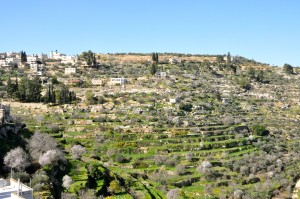
Village of BattirMoreover, the claim for a European olive heritage is challenged by the fact that, despite Europe’s prevalence in the olive market today, olive cultivation and production are primarily recognized as a meta-symbol of Mediterranean cultures, where non-European ones, notably in the Levant, have historical preeminence. The earliest evidence of olive cultivation in the world, dated back around ten thousand years, are olive pits found in excavations in different areas in Israel.[18] All over this region, ancient olive terraces, presses, and olive-oil industry related pottery instruments are found in archeological sites in enormous quantities, together with great amount of wild and ancient trees. From there, olive agriculture spread to Egypt and Asia Minor, and later throughout the Mediterranean.[19] This historical view on the origins of olive culture is debated, sometimes even ignored by Europocentric narratives.
Awareness of this legacy rivalry often intensifies and translates into identity and status contests, sometimes bearing concrete consequences.[20] For instance, while Italy is ahead of Turkey in market profits, in both countries, despite modernization processes, raw olive heritage is highly valued. However, ethnographic research found that in Tuscany traditional equipment – such as stone mill crushers and fabric-diaphragm presses – may be treasured but rarely used, even by smaller producers who rely on tourists. By contrast, Turkish farmers in the Ionian region tend to actively cherish and show stronger emotional connection to traditional procedures (e.g., avoiding artificial fertilizers), expressing concern of losing their unique cultural and historical ties.[21] In Israel and The Palestinian Authority, to take an extreme example, the claim for primacy of indigenous enduring olive heritage, fueled by an ongoing political conflict, is embedded in struggles of rural communities (both Arab and Jewish) striving for economic prospects or for social progress. Olive heritage discourses and action scripts are massively promoted by activists from both sides,[22] imbued with religious or nationalistic contents, on the one hand, or with environmental and social agendas, such as environmental justice, welfare and cross-cultural dialogue, or education and women-rights, on the other.
Rakefet Sela-Sheffy
[1] During, Roel 2011. « European heritage discourses, a matter of identity construction? » In Cultural Heritage and Identity Politics, Roel, During, ed. Wageningen: Wageningen UR/ The Silk Road Research Foundation, 17-30.
[2] Vossen, Paul 2007. « Olive oil: history, production, and characteristics of the world’s classic oils. » HortScience, 2007, 1093-1100.
[3] « Olive oil production in Turkey and Italy », http://blogs.lt.vt.edu/pgs2014/?page_id=3697
[4] Kapellakis, Iosif Emmanouil, Konstantinos P. Tsagarakis, and John C. Crowther 2008. « Olive oil history, production and by-product management ». Reviews in Environmental Science and Bio/Technology, 2008. 1-26.
[5] The EU olive and olive oil sector Briefing 2017, http://www.agro-alimentarias.coop/ficheros/doc/05461.pdf
[6] EU agricultural outlook 2017-2030, September 2017, https://ec.europa.eu/info/news/eu-agricultural-outlook-wine-olive-oil-and-fruits-vegetable-exports-grow_en
[7] Olive Oil source, https://www.oliveoilsource.com/page/olive-varietals
[8] Del Marmol, Camila, Marc Morell and Jasper Chalcraft (eds.) 2014. The Making of Heritage: Seduction and Disenchantment. Routledge Studies in Heritage.
[9] Sela, Igal 2010. Olive with two-thousand years of age? [in Hebrew] http://www.tau.ac.il/~rakefet/igalsela/Ibrit/MSS/IgalSela-2010–AceZayit.pdf
[10] Bernabei, Mauro 2015. « The age of the olive trees in the Garden of Gethsemane. » Journal of Archaeological Science 53, pp. 43-48.
[11] Genoveva Millán-Vazquez de la Torre, Maria, Juan Manuel Arjona-Fuentes and Luis Amador-Hidalgo 2016. « Olive oil tourism: Promoting rural development in Andalusia (Spain) ». Tourism Management Perspectives, 21, 100-108.
[12] The Best International EVOO Competitions, https://www.oliveoilmarket.eu/best-competitions/
[13] http://culture-routes.net/routes/the-routes-of-the-olive-tree
[14] « Trends in World Olive Oil consumption », International Olive Council, OliOOficiana Globe 20.03.2016, http://www.olioofficina.net/knowledge/economy/trends-in-world-olive-oil-consumption.htm. || Paravantes, Elena 2011. « Olive Oil Health Benefits », Olive Oil Times, 23.5.2011, https://www.oliveoiltimes.com/olive-oil-health-benefits.
[15] Billiard, Elise 2014. « Feeding disenchantment. On the heritage intricacies of cookery books and the olive oil festival in Malta. ». In Del Marmol, Camila, Marc Morell and Jasper Chalcraft (eds.), The Making of Heritage: Seduction and Disenchantment. London: Routledge, 140-157
[16] « Olive growing in Italy », OliOOficiana Globe, http://www.olioofficina.net/knowledge/economy/olive-growing-in-italy.htm.
[17] Ashifa Kassam, 2015. « Spain’s ancient olive trees under threat from market for garden ornaments », The Guardian, 31.12.2015. https://www.theguardian.com/world/2015/dec/31/spain-ancient-olive-trees-threat-garden-ornaments.
[18] Galili, Ehud, Daniel Jean Stanley, et al. 1997. « Evidence for Earliest Olive-Oil Production in Submerged Settlements off the Carmel Coast, Israel. » Journal of Archaeological Science 24 (12), 1141-1150.
[19] Liphschitz, Nili, Ram Gophna, et al. 1991. « The beginning of olive (olea europaea) cultivation in the old world: A reassessment. » Journal of Archaeological Science 18 (4), 441-453. || Newton, Claire, Christine Lorre, et al. 2014. « On the origins and spread of Olea europaea L. (olive) domestication: evidence for shape variation of olive stones at Ugarit, Late Bronze Age, Syria—a window on the Mediterranean Basin and on the westward diffusion of olive varieties. » Vegetation History and Archaeobotany 23 (5), 567-575.
[20] Even-Zohar, Itamar, 2017. « Who profits from legacy? » Paper presented at the ProPeace First Conference, Wageningen Environmental Research, Wageningen, January 16–20, 2017.
[21] « Olive Oil Production in Turkey and Italy » 2014, Presidential Global Scholars, 14.4.14,
[22] Meneley, Anne 2014. « Discourses of Distinction in Contemporary Palestinian Extra-Virgin Olive Oil Production », Food and Foodways, 22(1-2), 48-64.


 Université Jean Monnet
Université Jean Monnet